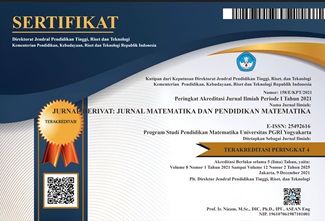Analisis Respon Siswa Terhadap Efektivitas Pembelajaran Matematika Kelas 10 Menggunakan Video Conference
DOI:
https://doi.org/10.31316/jderivat.v10i1.1525Abstract
The COVID-19 pandemic changed the offline learning system to online learning. Video conferencing can help teachers and students in the teaching and learning process to replace face-to-face learning into online. The purpose of this study was to find out how the effectiveness of learning mathematics using Video Conference during online learning. The research method used is a descriptive method using a survey method by describing student responses during learning using Video Conference and the results of the analysis to make conclusions. Video conferencing is effective in helping the teaching and learning process during online learning conditions.
Keyword: Response, Video Conference, Mathematics, Online Learning
References
Fauzi, M. S. D. (2021). Implementasi Paradigma Heutagogi dalam Pembelajaran Jarak Jauh di Perguruan Tinggi: Sebuah Sistematis Review. HEUTAGOGIA: Journal of Islamic Education, 1(1), 1-15.
Munir. (2012). Pembelajaran JarakJauh(2nd ed.). Bandung: Alfabeta
Setyosari, P. (2007). Pembelajaran Sistem Online: Tantangan dan Rangsangan. Jurnal Majalah Ilmiah Pembelajaran Edisi Oktober 2007No.2. Universitas Negeri Yogyakarta. Hal 7-8
Ghada Al-Hudhud. (2015). Aspect oriented design for team learning management system. Computers in Human Behavior. Elsevier Ltd. (pp. 627 -631)
H.M Burhan Bungin. (2011). Metode Penelitian Kuntitatif : Komunikasi, Ekonomi, dan Kebijakan Publik serta Ilmu-ilmu lainnya, Edisi Kedua(2nd ed.). Jakarta: Kencana Prenama Media Group.
Sudjana, Nana. & Ibrahim. 1989. Penelitian dan Penilaian Pendidikan. Bandung: Sinar Baru
Sukmadinata, S. N. (2005). Metode Penelitian. Bandung: PT remaja rosdakarya.
Soendari, T. (2012). Metode Penelitian Deskriptif. Bandung, UPI. Stuss, Magdalena & Herdan, Agnieszka, 17.
Published
Issue
Section
Citation Check
License
Copyright (c) 2023 Jurnal Derivat: Jurnal Matematika dan Pendidikan Matematika

This work is licensed under a Creative Commons Attribution-ShareAlike 4.0 International License.
Authors who publish with this journal agree to the following terms:
-
Authors retain copyright and grant the journal right of first publication with the work simultaneously licensed under a Creative Commons Attribution-ShareAlike 4.0 International License that allows others to share the work with an acknowledgment of the work's authorship and initial publication in this journal.
- Authors are able to enter into separate, additional contractual arrangements for the non-exclusive distribution of the journal's published version of the work (e.g., post it to an institutional repository or publish it in a book), with an acknowledgment of its initial publication in this journal.
- Authors are permitted and encouraged to post their work online (e.g., in institutional repositories or on their website) prior to and during the submission process, as it can lead to productive exchanges, as well as earlier and greater citation of published work (See The Effect of Open Access).







